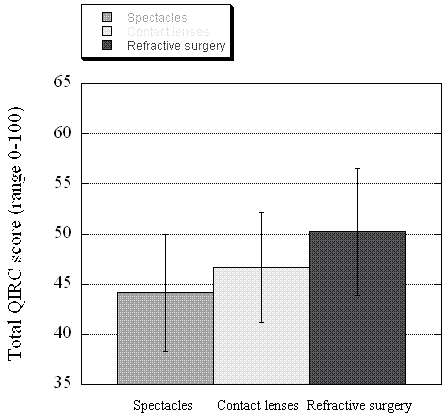A Quality of Life Comparison of People Wearing Spectacles or Contact Lenses or Having Undergone Refractive Surgery
Purpose. To demonstrate the utility of the Quality of Life Impact of Refractive Correction (QIRC) questionnaire for comparing people with refractive correction by spectacles, contact lenses or refractive surgery.
Methods. The 20-item QIRC questionnaire was administered to groups of 104 spectacle wearers, 104 contact lens wearers and 104 people who had undergone refractive surgery (total n=312). These groups were similar for gender, ethnicity, socioeconomic status and refractive error. The main outcome measure was QIRC overall score (scaled from 0-100), a measure of refractive correction-related quality of life. Groups were compared for overall QIRC score and on each question by ANOVA, adjusted for age, with post-hoc significance testing (Sheffé).
Results. Refractive surgery patients scored significantly better (mean QIRC score 50.2±6.3, F2,309=15.18, p<0.001), than contact lens wearers (46.7±5.5, post hoc p<0.001) who were in turn significantly better than spectacle wearers (44.1±5.9, post hoc p<0.01). Convenience questions chiefly drove the differences between groups, although functioning, symptoms, economic concerns, heath concerns and well-being were also important. Spectacle wearers with low strength prescriptions (46.18±5.05) scored significantly better than those with medium strength prescriptions (42.74±6.08, F2,190=3.66, p<0.05, post-hoc p<0.05). A small number (N=7, 6.7%) of refractive surgery patients experienced post-operative complications, which impacted QIRC score (37.86±2.13).

Figure 1. Columns showing mean (error bars±SD) responses for the total QIRC score by mode of refractive correction. Refractive surgery was significantly better than contact lenses (P<01) and spectacles (P<001). Contact lenses were significantly better than spectacles (P<.05).
Conclusion. QIRC effectively discriminates between mode of refractive correction. Quality of life was lowest in spectacle wearers, particularly those with higher corrections. Contact lens wearers had significantly better QIRC score. Refractive surgery patients scored significantly better than both, but this was accompanied by a small risk of poor quality of life due to complications.
Journal of Refractive Surgery Volume 22 January/February 2006; 19-27
Accepted for publication March 21, 2005.
Konrad Pesudovs, PhD1; Estibaliz Garamendi, PhD2; David B. Elliott, PhD2
1 From the Department of Ophthalmology, Flinders Medical Centre and
Flinders University, Adelaide, South Australia, Australia
2 Department of Optometry, University of Bradford, West Yorkshire, UK
 QIRC x-section as PDF (213 Kb)
QIRC x-section as PDF (213 Kb)
![]()
Index of Papers
[ Welcome ][ Publications ]

